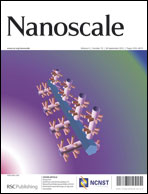Enhanced sensitivity of a direct SERS technique for Hg2+ detection based on the investigation of the interaction between silver nanoparticles and mercury ions
Abstract
Mercury which is a very important pollutant has drawn significant attention in recent research. So far, among the various detection methods, the strategies based on surface-enhanced Raman scattering (SERS) are quite attractive because of the high sensitivity, and especially as it is reported that Hg2+ can be directly detected by SERS without tagging. However, the procedure for the direct SERS detection of mercury is still unclear with little experimental evidence, limiting further development of Hg2+ detection by SERS. Herein, we performed a simple method based on SERS for the detection of mercury ions in water without tagging. It is established that in only 2 min, low concentration of Hg2+ can be recognized based on the decrease of SERS intensity. The detection procedure is investigated by multiple characterizations and the mechanism proven by the obtained data provides a practical way to further improve the sensitivity of the SERS detection. It is demonstrated that the interaction between Hg2+ and Ag nanoparticles (Ag NPs) could occur in a short time, which includes the complexation of Hg2+ with citrate and the formation of amalgam due to the reduction of Hg2+. This interaction influences the surface plasmon resonance (SPR) property of Ag NPs and thereby decays the electromagnetic enhancement of Ag NPs; meanwhile the interaction also causes the zeta potential decrease of Ag NPs and accordingly affects the adsorption of Raman reporter molecules on the surface of Ag NPs. Therefore, the weakness of SERS intensity in the presence of Hg2+ should be mainly attributed to the interaction between Hg2+ and Ag NPs. From the mechanism demonstrated, it can be speculated that using fewer Ag NPs in the detection could improve the sensitivity, because at low Hg2+ concentration the interaction becomes stronger since every Ag nanoparticle acts with more Hg2+ ions. Accordingly, we establish that 90.9 pM (18.2 ppt) Hg2+ is detected in 18 μM Ag NPs, which is much lower than that in reported papers.


 Please wait while we load your content...
Please wait while we load your content...